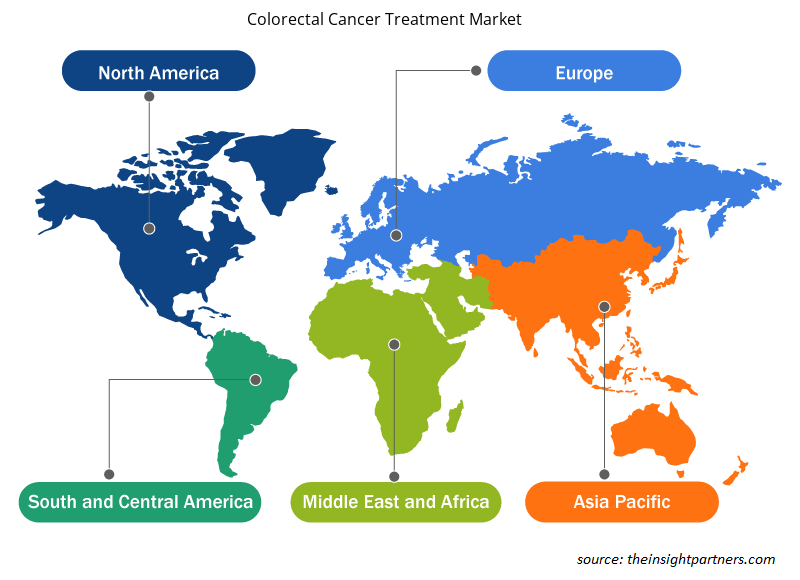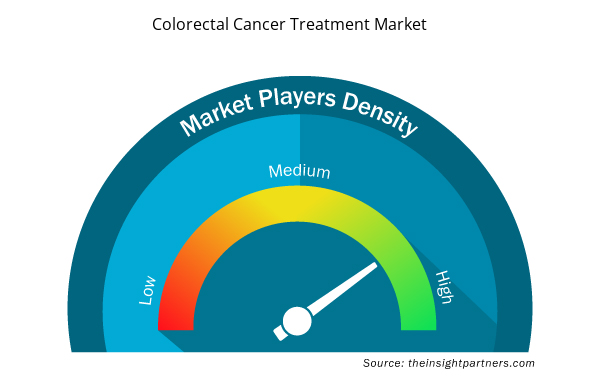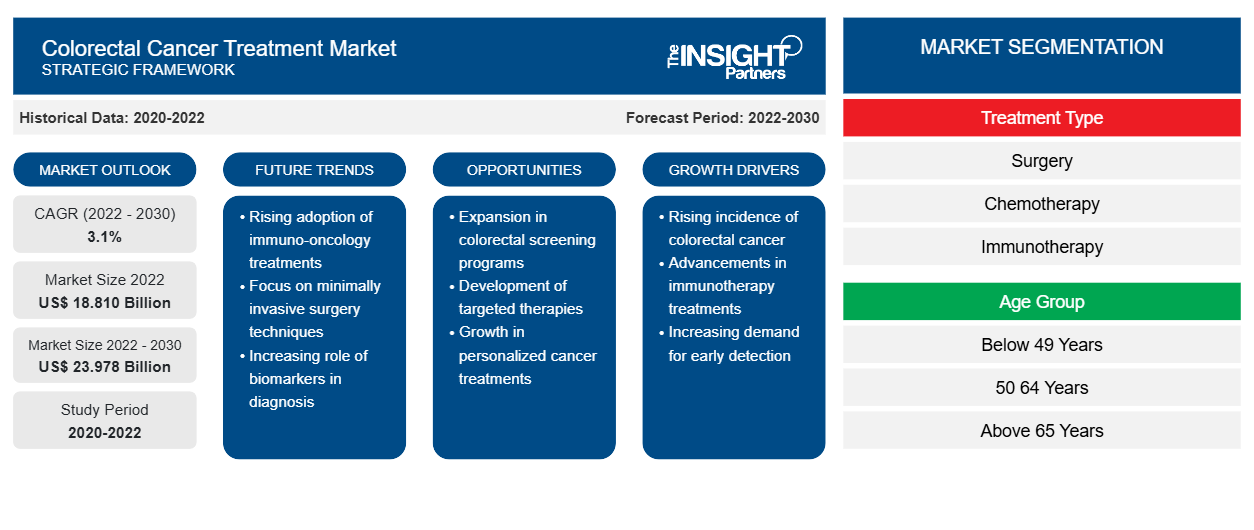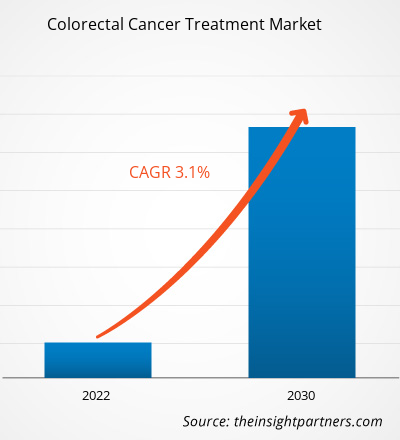[Rapport de recherche] Le marché du traitement du cancer colorectal était évalué à 18,810 milliards USD en 2022 et devrait atteindre 23,978 milliards USD d'ici 2030. Il devrait enregistrer un TCAC de 3,1 % en 2022-2030.
Informations sur le marché et point de vue des analystes :
La croissance du marché est due au nombre croissant de cas de cancer colorectal et à l'augmentation des approbations de thérapies ciblées et d'immunothérapies pour traiter le cancer colorectal. En outre, les initiatives stratégiques des entreprises pour rester compétitives sur le marché alimentent la croissance du marché. Une augmentation significative des médicaments personnalisés pour répondre aux besoins des clients en matière de traitement du cancer colorectal est susceptible d'apporter de nouvelles tendances sur le marché du traitement du cancer colorectal au cours de la période de prévision.
Moteurs de croissance et défis :
Le cancer colorectal est une tumeur maligne qui se développe dans les tissus du côlon ou du rectum. Des facteurs liés au mode de vie tels qu'une faible consommation de fruits et de légumes, la dépendance au tabac, la sédentarité, l'obésité, une consommation élevée de viandes transformées et une consommation excessive d'alcool contribuent à la croissance des cas de cancer colorectal. Il s'agit du troisième type de cancer le plus courant (à l'exclusion du cancer de la peau ) diagnostiqué chaque année aux États-Unis. En 2023, l'Organisation mondiale de la santé (OMS) a déclaré que le cancer colorectal était le troisième cancer le plus courant dans le monde et la deuxième cause de décès liés au cancer dans le monde. Selon la même source, environ 10 % du total des cas diagnostiqués dans le monde sont des cas de cancer colorectal. Selon les estimations de l'American Cancer Society, environ 106 000 nouveaux cas de cancer du côlon et environ 46 000 nouveaux cas de cancer du rectum ont été enregistrés aux États-Unis en 2023.
Selon les données fournies par le Système européen d'information sur le cancer, le cancer colorectal représentait environ 12,7 % de tous les nouveaux cancers diagnostiqués en 2020, et environ 12,4 % du total des décès étaient dus au cancer colorectal en 2020 dans les pays de l'UE-27. En raison de cette prévalence élevée, le cancer colorectal est le deuxième cancer le plus fréquent, après le cancer du sein, et la deuxième cause de décès liés au cancer, après le cancer du poumon. Selon le Centre international de recherche sur le cancer et GLOBOCAN, environ 1 million de nouveaux cas de cancer colorectal ont été signalés en Asie en 2020. Le Japon, la Malaisie, la Chine, Singapour, la Turquie et la Corée ont enregistré des taux de prévalence élevés par rapport aux autres pays d'Asie-Pacifique. En outre, d'ici 2040, la charge mondiale du cancer colorectal devrait augmenter de 72 % pour atteindre plus de 3 millions de nouveaux cas, ce qui constitue une grave menace pour la santé humaine. Ainsi, l'incidence croissante du cancer colorectal stimule la croissance du marché du traitement du cancer colorectal.
Personnalisez ce rapport en fonction de vos besoins
Vous bénéficierez d'une personnalisation gratuite de n'importe quel rapport, y compris de certaines parties de ce rapport, d'une analyse au niveau des pays, d'un pack de données Excel, ainsi que d'offres et de remises exceptionnelles pour les start-ups et les universités.
- Obtenez les principales tendances clés du marché de ce rapport.Cet échantillon GRATUIT comprendra une analyse de données, allant des tendances du marché aux estimations et prévisions.
Segmentation et portée du rapport :
L'analyse du marché du traitement du cancer colorectal a été réalisée en prenant en compte les segments suivants : type de traitement, tranche d'âge, utilisateur final et géographie. Le marché du traitement du cancer colorectal, par type de traitement, est segmenté en chirurgie, chimiothérapie , thérapie ciblée, immunothérapie et autres. En fonction de la tranche d'âge, le marché est divisé en moins de 49 ans, 50-64 ans et plus de 65 ans. Le marché, par utilisateur final, est segmenté en hôpitaux, cliniques spécialisées, soins à domicile et autres. La portée du rapport sur le marché du traitement du cancer colorectal comprend l'Amérique du Nord (États-Unis, Canada et Mexique), l'Europe (Espagne, Royaume-Uni, Allemagne, France, Italie et reste de l'Europe), l'Asie-Pacifique (Corée du Sud, Chine, Japon, Inde, Australie et reste de l'Asie-Pacifique), le Moyen-Orient et l'Afrique (Afrique du Sud, Arabie saoudite, Émirats arabes unis et reste du Moyen-Orient et de l'Afrique) et l'Amérique du Sud et centrale (Brésil, Argentine et reste de l'Amérique du Sud et centrale).
Analyse segmentaire :
Le marché du traitement du cancer colorectal, par type de traitement, est segmenté en chirurgie, chimiothérapie, thérapie ciblée, immunothérapie et autres. En 2022, le segment de la chirurgie détenait la plus grande part de marché du traitement du cancer colorectal et devrait enregistrer le TCAC le plus élevé au cours de la période 2022-2030. La chirurgie est considérée comme le traitement le plus courant pour tous les stades du cancer colorectal . Si le cancer est diagnostiqué à un stade précoce, des interventions chirurgicales sont alors effectuées pour retirer la tumeur.
En fonction de la tranche d’âge, le marché est segmenté en moins de 49 ans, 50-64 ans et plus de 65 ans. En 2022, le segment des plus de 65 ans détenait la plus grande part de marché du traitement du cancer colorectal et devrait enregistrer le TCAC le plus élevé au cours de la période 2022-2030. Selon un rapport de l’American Cancer Society, on estime que plus de la moitié des nouveaux cas diagnostiqués aux États-Unis concernent des personnes âgées de plus de 65 ans, et que plus des deux tiers de tous les décès par cancer colorectal ont été signalés chez des personnes âgées de plus de 65 ans.
En fonction de l’utilisateur final, le marché est divisé en hôpitaux, cliniques spécialisées, soins à domicile et autres. La taille du marché du traitement du cancer colorectal pour le segment hospitalier devrait augmenter au cours de la période 2022-2030.
Analyse régionale :
L'Amérique du Nord est le principal contributeur à la croissance du marché mondial du traitement du cancer colorectal. L'Asie-Pacifique devrait afficher le TCAC le plus élevé du marché au cours de la période 2022-2030. L'Amérique du Nord détenait la plus grande part du marché mondial en 2022 en raison du nombre croissant de cancers colorectaux, des avancées technologiques croissantes, de la forte prévalence du cancer colorectal chez les personnes de moins de 50 ans et de la présence d'acteurs clés du marché impliqués dans le développement de produits nouveaux et existants. En Amérique du Nord, les États-Unis détenaient la plus grande part du marché en 2022.
Développements de l'industrie et opportunités futures :
Les prévisions du marché du traitement du cancer colorectal sont estimées sur la base de diverses conclusions de recherche secondaires et primaires telles que les publications clés des entreprises, les données des associations et les bases de données. Les stratégies des principaux acteurs opérant sur le marché du traitement du cancer colorectal sont répertoriées ci-dessous :
- En novembre 2023, Takeda Pharmaceutical a annoncé avoir reçu l'approbation de la Food and Drug Administration (FDA) des États-Unis pour son traitement ciblé par voie orale FRUZAQLA (fruquintinib) pour traiter les adultes atteints d'un cancer colorectal métastatique (CCRm). FRUZAQLA est le premier et le seul inhibiteur sélectif des trois récepteurs kinases VEGF approuvé aux États-Unis pour le traitement du CCRm, quel que soit le statut des biomarqueurs.
- En août 2023, Taiho Pharmaceutical Co., Ltd. a annoncé que la FDA américaine avait approuvé LONSURF (trifluridine/tipiracil) en monothérapie et en association avec le bévacizumab pour le traitement des patients adultes souffrant de cancer colorectal métastatique. Ces patients sont auparavant traités par chimiothérapie à base d'oxaliplatine, de fluoropyrimidine et d'irinotécan, une thérapie biologique anti-VEGF.
Aperçu régional du marché du traitement du cancer colorectal
Les tendances et facteurs régionaux influençant le marché du traitement du cancer colorectal tout au long de la période de prévision ont été expliqués en détail par les analystes d’Insight Partners. Cette section traite également des segments et de la géographie du marché du traitement du cancer colorectal en Amérique du Nord, en Europe, en Asie-Pacifique, au Moyen-Orient et en Afrique, ainsi qu’en Amérique du Sud et en Amérique centrale.

- Obtenez les données régionales spécifiques au marché du traitement du cancer colorectal
Portée du rapport sur le marché du traitement du cancer colorectal
| Attribut de rapport | Détails |
|---|---|
| Taille du marché en 2022 | 18,810 milliards de dollars américains |
| Taille du marché d'ici 2030 | 23,978 milliards de dollars américains |
| Taux de croissance annuel moyen mondial (2022-2030) | 3,1% |
| Données historiques | 2020-2022 |
| Période de prévision | 2022-2030 |
| Segments couverts | Par type de traitement
|
| Régions et pays couverts | Amérique du Nord
|
| Leaders du marché et profils d'entreprises clés |
|
Densité des acteurs du marché du traitement du cancer colorectal : comprendre son impact sur la dynamique commerciale
Le marché du traitement du cancer colorectal connaît une croissance rapide, tirée par la demande croissante des utilisateurs finaux en raison de facteurs tels que l'évolution des préférences des consommateurs, les avancées technologiques et une plus grande sensibilisation aux avantages du produit. À mesure que la demande augmente, les entreprises élargissent leurs offres, innovent pour répondre aux besoins des consommateurs et capitalisent sur les tendances émergentes, ce qui alimente davantage la croissance du marché.
La densité des acteurs du marché fait référence à la répartition des entreprises ou des sociétés opérant sur un marché ou un secteur particulier. Elle indique le nombre de concurrents (acteurs du marché) présents sur un marché donné par rapport à sa taille ou à sa valeur marchande totale.
Les principales entreprises opérant sur le marché du traitement du cancer colorectal sont :
- Genentech Inc
- Eli Lilly et compagnie
- Pfizer Inc
- Takeda Pharmaceuticals
- Bristol Myers Squibb
Avis de non-responsabilité : les sociétés répertoriées ci-dessus ne sont pas classées dans un ordre particulier.

- Obtenez un aperçu des principaux acteurs du marché du traitement du cancer colorectal
Paysage concurrentiel et entreprises clés :
Genentech Inc, Eli Lilly and Company, Pfizer Inc, Takeda Pharmaceuticals, Bristol Myers Squibb, Merck, Bayer AG, Regeneron Pharmaceuticals Inc, Novartis AG et Ipsen Biopharmaceuticals Inc figurent parmi les principaux acteurs présentés dans le rapport sur le marché du traitement du cancer colorectal. En outre, plusieurs autres acteurs ont été étudiés et analysés au cours de l'étude pour obtenir une vue holistique du marché et de son écosystème. Ces entreprises se concentrent sur les expansions géographiques et les lancements de nouveaux produits pour répondre à la demande croissante des consommateurs du monde entier et élargir leur gamme de produits dans des portefeuilles spécialisés. Leur présence mondiale leur permet de servir une large clientèle, facilitant ainsi l'expansion du marché.
- Analyse historique (2 ans), année de base, prévision (7 ans) avec TCAC
- Analyse PEST et SWO
- Taille du marché Valeur / Volume - Mondial, Régional, Pays
- Industrie et paysage concurrentiel
- Ensemble de données Excel



Report Coverage
Revenue forecast, Company Analysis, Industry landscape, Growth factors, and Trends

Segment Covered
This text is related
to segments covered.

Regional Scope
North America, Europe, Asia Pacific, Middle East & Africa, South & Central America

Country Scope
This text is related
to country scope.
Questions fréquemment posées
The colorectal cancer treatment market majorly consists of the players such Genentech Inc, Eli Lilly and Company, Pfizer Inc, Takeda Pharmaceuticals, Bristol Myers Squibb, Merck, Bayer AG, Regeneron Pharmaceuticals Inc, Novartis AG, and Ipsen Biopharmaceuticals Inc.
Based on geography, the colorectal cancer treatment market is segmented into North America (the US, Canada, and Mexico), Europe (the UK, Germany, France, Italy, Spain, and the Rest of Europe), Asia Pacific (China, Japan, India, South Korea, Australia, and the Rest of Asia Pacific), the Middle East & Africa (the UAE, Saudi Arabia, South Africa, and Rest of the Middle East & Africa), and South & Central America (Brazil, Argentina, and the Rest of South & Central America). North America is the largest contributor to the growth of the global colorectal cancer treatment market. Asia Pacific is expected to register the highest CAGR in the colorectal cancer treatment market during 2022–2030.
Colorectal cancer often begins as a growth called a polyp inside the colon or rectum. Colorectal cancer happens when there are changes in genetic material (DNA). These changes are also called mutations or variants. Often, the genetic changes that lead to colorectal cancer happen during lifetime and the exact cause is unknown. Colorectal cancer treatment includes surgery, chemotherapy, radiation therapy, targeted therapy, immunotherapy, cryosurgery, and radiofrequency ablation.
The growing number of colorectal cancer cases and the subsequent increase in product launches are factors predominantly driving the colorectal cancer treatment market size. However, the high cost associated with colorectal cancer treatment in developing countries hinders the market growth.
The colorectal cancer treatment market, by treatment type, is segmented into surgery, chemotherapy, targeted therapy, immunotherapy, and others. In 2022, the surgery segment held the largest colorectal cancer treatment market share and is expected to record the highest CAGR during 2022–2030.
Based on age group, the market is segmented into below 49 years, 50–64 years, and above 65 years. In 2022, the above 65 years segment held the largest colorectal cancer treatment market share and is projected to record the highest CAGR during 2022–2030.
Based on end user, the market is divided into hospitals, specialty clinics, home care, and others. The colorectal cancer treatment market size for the hospital segment is likely to surge during 2022–2030.
Trends and growth analysis reports related to Life Sciences : READ MORE..
The List of Companies - Colorectal Cancer Treatment Market
- Genentech Inc
- Eli Lilly and Company
- Pfizer Inc
- Takeda Pharmaceuticals
- Bristol Myers Squibb
- Merck
- Bayer AG
- Regeneron Pharmaceuticals Inc
- Novartis AG
- Ipsen Biopharmaceuticals
The Insight Partners performs research in 4 major stages: Data Collection & Secondary Research, Primary Research, Data Analysis and Data Triangulation & Final Review.
- Data Collection and Secondary Research:
As a market research and consulting firm operating from a decade, we have published and advised several client across the globe. First step for any study will start with an assessment of currently available data and insights from existing reports. Further, historical and current market information is collected from Investor Presentations, Annual Reports, SEC Filings, etc., and other information related to company’s performance and market positioning are gathered from Paid Databases (Factiva, Hoovers, and Reuters) and various other publications available in public domain.
Several associations trade associates, technical forums, institutes, societies and organization are accessed to gain technical as well as market related insights through their publications such as research papers, blogs and press releases related to the studies are referred to get cues about the market. Further, white papers, journals, magazines, and other news articles published in last 3 years are scrutinized and analyzed to understand the current market trends.
- Primary Research:
The primarily interview analysis comprise of data obtained from industry participants interview and answers to survey questions gathered by in-house primary team.
For primary research, interviews are conducted with industry experts/CEOs/Marketing Managers/VPs/Subject Matter Experts from both demand and supply side to get a 360-degree view of the market. The primary team conducts several interviews based on the complexity of the markets to understand the various market trends and dynamics which makes research more credible and precise.
A typical research interview fulfils the following functions:
- Provides first-hand information on the market size, market trends, growth trends, competitive landscape, and outlook
- Validates and strengthens in-house secondary research findings
- Develops the analysis team’s expertise and market understanding
Primary research involves email interactions and telephone interviews for each market, category, segment, and sub-segment across geographies. The participants who typically take part in such a process include, but are not limited to:
- Industry participants: VPs, business development managers, market intelligence managers and national sales managers
- Outside experts: Valuation experts, research analysts and key opinion leaders specializing in the electronics and semiconductor industry.
Below is the breakup of our primary respondents by company, designation, and region:

Once we receive the confirmation from primary research sources or primary respondents, we finalize the base year market estimation and forecast the data as per the macroeconomic and microeconomic factors assessed during data collection.
- Data Analysis:
Once data is validated through both secondary as well as primary respondents, we finalize the market estimations by hypothesis formulation and factor analysis at regional and country level.
- Macro-Economic Factor Analysis:
We analyse macroeconomic indicators such the gross domestic product (GDP), increase in the demand for goods and services across industries, technological advancement, regional economic growth, governmental policies, the influence of COVID-19, PEST analysis, and other aspects. This analysis aids in setting benchmarks for various nations/regions and approximating market splits. Additionally, the general trend of the aforementioned components aid in determining the market's development possibilities.
- Country Level Data:
Various factors that are especially aligned to the country are taken into account to determine the market size for a certain area and country, including the presence of vendors, such as headquarters and offices, the country's GDP, demand patterns, and industry growth. To comprehend the market dynamics for the nation, a number of growth variables, inhibitors, application areas, and current market trends are researched. The aforementioned elements aid in determining the country's overall market's growth potential.
- Company Profile:
The “Table of Contents” is formulated by listing and analyzing more than 25 - 30 companies operating in the market ecosystem across geographies. However, we profile only 10 companies as a standard practice in our syndicate reports. These 10 companies comprise leading, emerging, and regional players. Nonetheless, our analysis is not restricted to the 10 listed companies, we also analyze other companies present in the market to develop a holistic view and understand the prevailing trends. The “Company Profiles” section in the report covers key facts, business description, products & services, financial information, SWOT analysis, and key developments. The financial information presented is extracted from the annual reports and official documents of the publicly listed companies. Upon collecting the information for the sections of respective companies, we verify them via various primary sources and then compile the data in respective company profiles. The company level information helps us in deriving the base number as well as in forecasting the market size.
- Developing Base Number:
Aggregation of sales statistics (2020-2022) and macro-economic factor, and other secondary and primary research insights are utilized to arrive at base number and related market shares for 2022. The data gaps are identified in this step and relevant market data is analyzed, collected from paid primary interviews or databases. On finalizing the base year market size, forecasts are developed on the basis of macro-economic, industry and market growth factors and company level analysis.
- Data Triangulation and Final Review:
The market findings and base year market size calculations are validated from supply as well as demand side. Demand side validations are based on macro-economic factor analysis and benchmarks for respective regions and countries. In case of supply side validations, revenues of major companies are estimated (in case not available) based on industry benchmark, approximate number of employees, product portfolio, and primary interviews revenues are gathered. Further revenue from target product/service segment is assessed to avoid overshooting of market statistics. In case of heavy deviations between supply and demand side values, all thes steps are repeated to achieve synchronization.
We follow an iterative model, wherein we share our research findings with Subject Matter Experts (SME’s) and Key Opinion Leaders (KOLs) until consensus view of the market is not formulated – this model negates any drastic deviation in the opinions of experts. Only validated and universally acceptable research findings are quoted in our reports.
We have important check points that we use to validate our research findings – which we call – data triangulation, where we validate the information, we generate from secondary sources with primary interviews and then we re-validate with our internal data bases and Subject matter experts. This comprehensive model enables us to deliver high quality, reliable data in shortest possible time.


 Obtenez un échantillon gratuit pour ce rapport
Obtenez un échantillon gratuit pour ce rapport